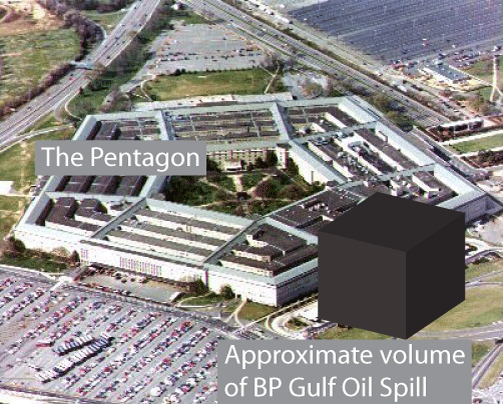This past week has seen a lot of news stories about a "Manhattan-sized" plume of oil found in the Gulf of Mexico by researchers near the site of the BP Deepwater Horizon well. This sent my BS detector into the yellow zone, so I have been trying to get a better idea of just how much oil remains in the Gulf from this disaster. It's definitely not gone.
So I went to Wikipedia. There, you can find a reference to a New York Times article from the beginning of August, where the total volume of the leak was estimated to be 780,000 cubic meters of oil. Now, that's clearly in the category of "reasonable guess" - no one knows for sure. But it is very unlikely to be a factor of two larger or smaller than that, so let's just use that for now. There are a lot of other uncertainties, for example the amount of natural gas (methane) that came out with the oil, how the flow rate changed with time, and so on. But again, let's just ignore those.
How big is 780,000 cubic meters? Simply taking the cube root of this number, this is the volume of a cube 92 meters on a side. It would look something like this next to the Pentagon:

I can imagine two reactions to this comparison: 1) Damn, that's a lot of oil! 2) That's tiny compared to the volume of the Gulf of Mexico! (I bet one's political views might play a role in which reaction comes first...)
If we were to take this volume and spread it out in a layer 1 millimeter thick, it would cover an area of 780 million square meters, which is a square about 28 kilometers on a side. The satellite images of the oil slick showed affected regions much larger than that, from which I conclude that the thickness of the surface layer must have been much less than 1 millimeter at those times. (But check my math, somebody!)
If all the oil were dissolved uniformly into the Gulf, which has a total volume three billion times the size of the leak, the concentration would be about one third of one part per billion. That's an interesting number all by itself, and not at all as small as it seems. But not all the oil leaked is in the Gulf - much of it evaporated and a good deal has been consumed by bacteria. But the rest of it went somewhere, right?
Now to the underwater plume. In the abstract of the Science Magazine paper that led to all the news stories, the authors said "Our findings indicate the presence of a continuous plume over 35 km in length, at approximately 1100 m depth that persisted for months without substantial biodegradation." I cannot find the word "Manhattan" anywhere in their article, and so I have to conclude this was some mainstream media (WSJ?) person's rather inept attempt at putting the size of the plume into perspective. It was parroted endlessly in the media as if it had meaning. In fact it's quite misleading - clearly the term "Manhattan-sized" conjures up images of the whole island of Manhattan along with all the tall buildings...but as we have seen the total volume of oil leaked into the Gulf is about the size of one of those buildings.
So what is this plume? The authors define it as "a discrete spatial interval with hydrocarbon signals or signal surrogates (i.e., colored dissolved organic matter or aromatic hydrocarbon fluorescence) more than two standard deviations above the root-mean-square baseline variability." That is, a place in the water where there is clearly oil present at detectable levels. It can be at quite low concentrations and still be detectable. One of the article's main findings was that "Gas chromatographic analyses for only monoaromatic hydrocarbons of several water samples gathered using survey guidance confirm benzene, toluene, ethylbenzene, and total xylenes (BTEX) concentrations in excess of 50 μg L-1 within the plume at 16 km downrange from the well site." This is all bad stuff we don't want in the water or getting into the food we eat.
I assume a lot more scientific research will need to be done to know the actual damage that the presence of these oil components will do to marine life, the fisheries, and the food chain. The authors took a stab at making an estimate of how much oxygen depletion was occurring due to biodegradation of the oil, concluding that "it may require many months before microbes significantly attenuate the hydrocarbon plume to the point that oxygen minimum zones develop that are intense enough...to threaten Gulf fisheries." That's good news for marine life, I assume, but means that the subsurface oil will take quite some time to be bioegraded, which is bad in the longer term. So why hasn't the media talked about that aspect of the article?
There is no question that this was a huge amount of oil leaked into the Gulf and that the impacts will be felt for many years to come. It is an epic disaster by any measure and may have consequences no one has considered yet. But we have to be rational about the real impacts of the disaster, and rational about the real risks involved in deep water drilling. The only way is to continue vigorously the kind of research we saw in the Science Magazine article, and debate the findings openly. BP needs to release publicly everything it knows about the spill.













